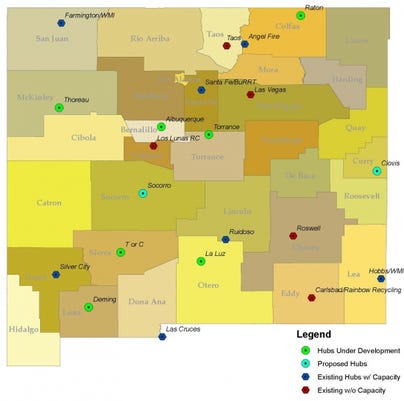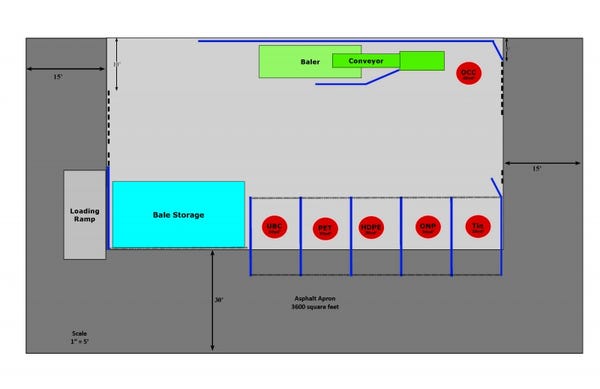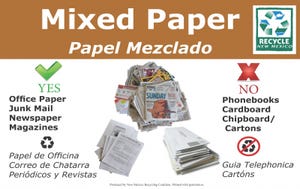A Rural Recycling Revolution
Trying a hub-and-spoke approach to rural recycling in New Mexico.
November 11, 2011
By English Bird, executive director of the New Mexico Recycling Coalition
New Mexico is a large, beautiful state with a low population density; roughly 85 percent of its communities are classified as rural. It’s a land of wide-open spaces, where one drives down the highway and wonders where that next gas station might be. Setting up a household material recycling program here requires determination, creativity and sheer will power. Capturing and processing bottles, cans and fibers can be tricky due to the challenges characteristic of most rural recycling projects: transportation, limited material volumes and operational costs.
As the statewide advocate for recycling, the New Mexico Recycling Coalition (NMRC) has heard many times from interested communities that want to start a program but run into rural recycling headaches. For example, one community had a recyclables collection trailer set up, but the only volunteer willing to tow it the necessary 200 miles to the nearest materials recovery facility (MRF) eventually moved away. Another community started collecting a material only to discover that there was no end-market for that material. In a third community, the unattended drop-off site became just another illegal dumping ground, and the recyclables suffered from constant contamination.
The Hub and Spoke Evolution
To help foster recycling and overcome these stumbling blocks, NMRC took a multi-year strategic planning approach, eventually developing a “hub-and-spoke” model of regionalized processing. The first step was to understand the current state of recycling in New Mexico. Geographic information system (GIS) tools were used to map the state’s waste sheds, identifying how trash and recycling flowed, as well the location of current recycling processing infrastructure. The resulting map revealed recycling “holes,” where infrastructure investments were most needed to support recycling.
 The potential hub locations were first identified in 2009. Three initiatives were established to boost recycling in these areas. First, six new recycling processing facilities (hubs) will come on line by the end of 2011, paid for by two different federal funding sources. Second, in conjunction with the strategic development of recycling processing infrastructure, NMRC will launch a marketing cooperative to help smaller hubs gain fair market pricing. The cooperative will also facilitate “milk runs” between processors in order to fill trucks, minimizing storage and transport time for individual materials. These milk runs allow smaller hubs to receive regular pick-up of materials for recycling, with a truck running a route between several regionalized locations in order to gain a full load. Finally, a Pay-As-You-Throw (PAYT) education campaign will explain this alternative solid waste collection rate model to communities, with the goal of establishing several pilot PAYT communities in New Mexico during the next two years. (Currently, only one community in the state employs PAYT.)
The potential hub locations were first identified in 2009. Three initiatives were established to boost recycling in these areas. First, six new recycling processing facilities (hubs) will come on line by the end of 2011, paid for by two different federal funding sources. Second, in conjunction with the strategic development of recycling processing infrastructure, NMRC will launch a marketing cooperative to help smaller hubs gain fair market pricing. The cooperative will also facilitate “milk runs” between processors in order to fill trucks, minimizing storage and transport time for individual materials. These milk runs allow smaller hubs to receive regular pick-up of materials for recycling, with a truck running a route between several regionalized locations in order to gain a full load. Finally, a Pay-As-You-Throw (PAYT) education campaign will explain this alternative solid waste collection rate model to communities, with the goal of establishing several pilot PAYT communities in New Mexico during the next two years. (Currently, only one community in the state employs PAYT.)
These three programs all come with technical assistance, which has been critical in gaining the political and departmental support while building the confidence necessary to take the next steps in developing new and expanded recycling programs.
NMRC received funding of $2.8 million for this work through a Department of Energy American Recovery and Reinvestment Act (ARRA) Energy Efficiency and Conservation Block Grant (EECBG). More than two-thirds of that money will be disseminated to rural and underserved communities to invest in recycling infrastructure. NMRC Technical Projects Director Justin Stockdale and Deputy Director Sarah Pierpont were critical in the development of this plan. Since receiving the grant, the organization has added a community recycling outreach specialist, Jessi Just, whose primary objective is to ensure communities succeed with their new recycling programs.
It's All About Efficiency
While far from a state-of-the-art materials recovery facility (MRF), the hub-and-spoke design allows for simplicity and efficiency. The template recycling processing hub is a simple, 3,000-square-foot, three-sided structure meant to house loose and baled source separated materials and a horizontal baler with a pit conveyor. It’s nothing fancy; it contains no offices, heating or restroom facilities, and is lit only by natural skylights. Moreover, it is designed so that the source-separated materials are handled as little as possible. Roll-offs and trailers are brought in to the hub and tipped directly into a right-sized storage bunker. Once full, a skid steer can push the material (exactly enough for a complete bale) directly to the pit conveyor.
The hub, as the operator of the processing equipment, retains the revenues from material sales, which offset the costs of operating and maintaining the equipment. Carefully locating the hubs minimizes competition for the scattered supply of recyclables. The hub infrastructure is also scalable, allowing for growth under the existing footprint and limiting costs at start up.

In most cases, the spokes, which collect materials from the hub’s region at convenient drop-off locations, do not share in that revenue but benefit in other ways, including avoided tipping fees, reduced transportation costs (in cases where the recycling hub is closer than the landfill), and the avoided costs of capitalizing and owning processing equipment.
NMRC recommends that every spoke maintain two distinct pieces of collection equipment: one for cardboard and another for sorted materials. Conventional divided-gable-topped roll-off containers are scaled to ensure that compartments fill at similar rates and to avoid hauling unused capacity. Spoke equipment haulers are also encouraged to have a switch-out set of equipment on hand to leave an empty container in the place of the full one to reduce transport trips. New spoke collection sites are optimally located at existing solid waste drop-off locations that have attendants. In an urban environment, locating the spoke near the local fire or police department discourages improper use and illegal dumping. In some locations, the staff locks the collection doors at night to avoid contamination.
Land of Investment
There are several different grant programs at work here and the costs to expand the hubs vary. The turn-key recycling processing centers come complete with a forklift, a horizontal baler and pit conveyor, the structure, electrical work and a loading dock along with start-up collection equipment. The three NMRC-funded communities — City of Deming, Otero County and Torrance County — were each awarded $309,820 to cover these expenses.
A second ARRA grant to the State of New Mexico funded a “balers and trailers” program in the cities of Raton, Truth or Consequences and Gallup. Under this program, communities provided existing light industrial space to house a grant-supported baler, conveyor and collection equipment. These hubs each received $150,000 to start their programs. After another round of spoke-specific grants, NMRC expects to see close to 40 new collection points in the state by the end of 2011. This effort will provide some of New Mexico’s smallest communities with access to recycling. Many larger rural towns and cities in the state will also gain access to traditional household recycling for the first time.
Another step will be to work with existing city-specific processing facilities. NMRC is assisting several of these communities to identify needed improvements or to build relationships necessary to foster regional partnerships to expand recycling collections for that geographic range. Each of the newly funded hubs receive assistance in developing strong, regionally-consistent education and outreach programs, complete with standardized signage, brochures, flyers, posters, magnets, household collection containers and newspaper articles. Each community has a citizens group in place that will aid the region in the ongoing public education and outreach requirements to expand and sustain the program.
(Cowboy) Boots on the Ground
Torrance County, one of the new turn-key recycling hub communities, completed their structure and had the baler installed in September 2011. It began accepting recyclables in October. The county has a little more than 16,000 residents and uses a regional joint power governmental entity, the Estancia Valley Solid Waste Authority (EVSWA), to manage the local landfill and solid waste operations. EVSWA oversees nine solid waste drop-offs and currently diverts brush, scrap metal, appliances, tires, auto batteries and auto fluids, in addition to recycling mulch through mortality composting and septage composting operations at the Estancia Valley Regional Landfill. Previously, the county did not offer recycling of cardboard, paper, plastics or tin cans due to the inability to process or manage those materials.
“By locating the new recycling processing center at the landfill, we are streamlining our operations to really focus on all waste management taking placing under one roof,” says Joseph Ellis, manager of the EVSWA. “The recycling and solid waste flows from the drop-offs to the same location. Without the ability to process these materials for the end-market, it did not make economical sense to collect these items in the past. Now, when we produce one bale of cardboard we are realizing revenue of $100, rather than costing $37 to bury that same material.”
Jobs, Energy and Markets
 New Mexico’s current recycling rate is 14 percent. NMRC predicts that the combined infrastructure development, marketing cooperative and PAYT awareness program will help New Mexico achieve a 17 percent recycling rate within three years and a 21 percent recycling rate in six years. Based on the Institute for Local Self Reliance’s calculation that every 10,000 new tons of material diverted equates to 10 new jobs, the state would see 62 new jobs in three years related to the handling, processing, brokering, transport and re-manufacture of these materials. That new tonnage will also equate to approximately 15 million MMBTUs of total energy saved or the equivalent of 139,340 households’ annual energy consumption.
New Mexico’s current recycling rate is 14 percent. NMRC predicts that the combined infrastructure development, marketing cooperative and PAYT awareness program will help New Mexico achieve a 17 percent recycling rate within three years and a 21 percent recycling rate in six years. Based on the Institute for Local Self Reliance’s calculation that every 10,000 new tons of material diverted equates to 10 new jobs, the state would see 62 new jobs in three years related to the handling, processing, brokering, transport and re-manufacture of these materials. That new tonnage will also equate to approximately 15 million MMBTUs of total energy saved or the equivalent of 139,340 households’ annual energy consumption.
In many ways, rural areas represent the great untapped frontier of recyclable material, a source to help our national recycling rate inch above 33 percent while creating new, local level jobs.
English Bird is the executive director of the New Mexico Recycling Coalition (NMRC), a nonprofit education and advocacy organization with a mission to lead New Mexico to value waste as a resource.
This material is also based upon work supported by the Department of Energy [National Nuclear Security Administration] under Award Number DE-EE0003799.
Disclaimer: “This report was prepared as an account of work sponsored by an agency of the United States government. Neither the United States government nor any agency thereof, nor any of their employees, makes any warranty, express or implied, or assumes any legal liability or responsibility for the accuracy, completeness, or usefulness of any information, apparatus, product, or process disclosed, or represents that its use would not infringe privately owned rights. Reference herein to any specific commercial product, process, or service by trade name, trademark, manufacturer, or otherwise does not necessarily constitute or imply its endorsement, recommendation, or favoring by the United States government or any agency thereof. The views and opinions of authors expressed herein do not necessarily state or reflect those of the United States government or any agency thereof.”
You May Also Like


